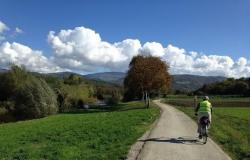In the painting of Silvestro Legaa Giuseppe Mazzini now elderly, he is portrayed a few hours before his death, lying on the bed, his eyes closed and his body abandoned waiting for his destiny to be fulfilled. Human, composed in all his fragile and dignified humanity, perhaps tired, but certainly not afraid of what awaits him. The painting by the painter from Modigliana, of a realism that captures the luminous accents with extraordinary technical skill and transforms the absence of gestures into a photography of great intensity, is at the center of the exhibition project that the VIVE museum center in Rome dedicates to the “Father of the Fatherland” – The last portrait: Mazzini and Lega, parallel stories of the Risorgimento – ongoing until‘8 September 2024 at the Sala Zanardelli of the Vittoriano.
“The last moments of Giuseppe Mazzini” by Silvestro Lega
The result of a loan arrived from overseas, through the direct involvement of the Ministry led by Gennaro Sangiuliano, which made it possible to materialize the agreement reached with the Museum of Art, Rhode Island School of Design in Providence. In fact, the smallest state in the USA preserves Lega’s masterpiece, who with Giovanni Fattori and Telemaco Signorini is considered among the greatest exponents of the Macchiaioli movement: the artist, a fervent supporter of Mazzini and follower of republican ideals, conceived The last moments of Giuseppe Mazzini on 12 March 1872 in Pisa, in the house of Pellegrino Rosselli and his wife Janeth Nathan, directly in front of the body of Giuseppe Mazzini, who had died there two days earlier under the pseudonym of George Brown. Lega returns a completely new image and far from the official one of the imperturbable hero that Mazzini himself had helped to create, paying homage to him however with a portrait of heartfelt emotional closeness (initially poorly received in Italy, precisely because it focuses on the fragility of the hero) , and also ensuring a painful private passage of the life of one of the great protagonists of the Risorgimento to collective memory.
The article continues below
1 / 11
 2 / 11
2 / 11
 3 / 11
3 / 11
 4 / 11
4 / 11
 5 / 11
5 / 11
 6 / 11
6 / 11
 7 / 11
7 / 11
 8 / 11
8 / 11
 9 / 11
9 / 11
 10 / 11
10 / 11
 11 / 11
11 / 11
The exhibition on the Risorgimento and its hero at the Vittoriano in Rome
So let Lega’s painting return to Italy to be exhibited at Victorianeven if only temporarily, seems to fulfill an ideal connection with the place that welcomes it, originally conceived as a symbolic monument of the Risorgimento: its construction, started in 1885 under the guidance of the architect Giuseppe Sacconi, will end only in 1935; already in 1911, however, the monument was officially inaugurated and opened to the public on the occasion of the celebrations of the fiftieth anniversary of the Unification of Italy. “The Vittoriano, the House of the Italian Risorgimento, is the natural place to host the exhibition dedicated to Giuseppe Mazzini, who is the one who best embodied the values and personified the deeds of that historical founding process of the Nation. The extent of his commitment and his political stature have gone beyond the boundaries of Italian history to make him a leading exponent of Western thought”, explains Minister Sangiuliano in this regard.
“The Vittoriano, home to the Altare della Patria, represents the most important monument that the Italian State has dedicated to the Risorgimento and therefore also to Giuseppe Mazzini. The legacy of Mazzini’s values can be traced in many parts of the complex, such as the bronze sculptural groups depicting Thought and Action. echoes the director of VIVE, Edith Gabrielli “The choice of our Institute by the Ministry of Culture for the organization of such a high-profile exhibition is completely natural and has triggered an extraordinary network of collaborations with as many as fifteen museum institutes and bodies, among the main custodians of the heritage of the two protagonists, Giuseppe Mazzini and Silvestro Lega”.

Giuseppe Mazzini and Silvestro Lega compared at the Vittoriano
The exhibition, curated by Gabrielli, with the historical consultancy of Giuseppe Monsagrati and in agreement with the Institute for the History of the Italian Risorgimento directed by Alessandro Campi, also offers other ideas, in addition to Lega’s painting. There are over sixty works and documents that can be discovered along the visit itinerary, including sculptures, paintings, engravings, photographs, manuscripts, unpublished documents and Mazzini relics (such as Mazzini’s glasses, sword and shawl, which previously belonged to Carlo Cattaneo).
The exhibition, organized on two floors, is divided into four sections and is completed with an immersive room: on the first floor the protagonist is Mazzini, immortalized in a recent acquisition of the museum – the Bust created by the Pavia sculptor Giovanni Spertini in 1878, with the band bearing one of Mazzini’s most famous mottos: “GOD AND THE PEOPLE” – and still told for the commitment placed in the development and diffusion of his public image, through his correspondence, testimonies from the newspaper ” La Giovine Italia, works by great artists of the time such as Francesco Hayez, Giovanni Migliara And Massimo D’Azeglio. On the second floor, however, the exhibition develops around the profile of Silvestro Lega.
To integrate the project, an educational program aimed at all age groups – from guided tours dedicated to adults to workshops for children and families – and the exhibition catalogue, published by Electa in Italian and English.
Livia Montagnoli
Artribune is also on Whatsapp. Simply click here to subscribe to the channel and always be updated



















